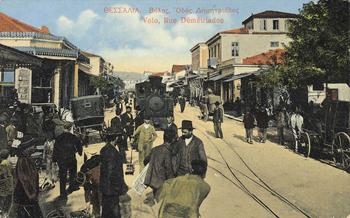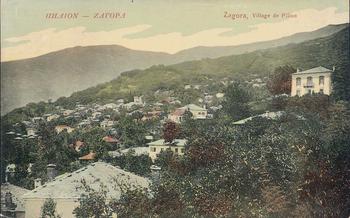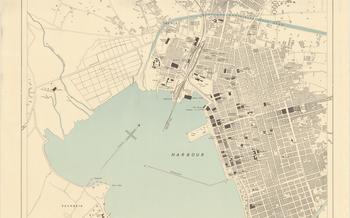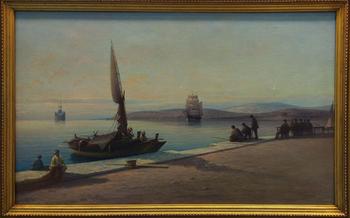
Agria's Railroad Museum
- The Rebirth of a Railway Symbol
- A Journey Through Time
- Steam Locomotives: The Stars of the Show
- From Tokens to Tickets: A Glimpse into Operations
- The Human Element: Stories of Railway Workers
- A Haven for Railway Enthusiasts
- Interactive Exhibits for a Hands-On Experience
- Preserving the Past, Inspiring the Future
- A Unique Venue for Events
- Reaching the Agria's Railroad Museum
- Hours of Operation and Admission Fees:
- Exploring the Enchanting City of Volos
- Capturing the Essence of Agria
- A Culinary Adventure in Volos
The Rebirth of a Railway Symbol
In the heart of Volos, Greece, lies a testament to the rich railway history of the nation—the Agria's Railroad Museum. Once a bustling train station, the site has been meticulously transformed into a museum, preserving the legacy of the Greek railway system. The museum stands as a symbol of the enduring significance of railways in shaping the country's transportation infrastructure and cultural heritage.
The Agria's Railroad Museum is not merely a collection of artifacts; it is a living tribute to the dedication and ingenuity of generations of railway workers who tirelessly connected cities, towns, and villages across Greece. As visitors step through the doors of the museum, they embark on a journey through time, where the echoes of steam locomotives and the clatter of wheels on tracks still linger in the air.
A Journey Through Time
The Agria's Railroad Museum takes visitors on a captivating journey through the annals of Greek railway history. Inside the museum, a treasure trove of exhibits awaits, showcasing the remarkable evolution of transportation in the country. Vintage locomotives, carriages, and an array of artifacts narrate the story of Greece's railway system, from its humble beginnings to its present-day status as a vital part of the country's infrastructure. Step into the museum, and be transported to a bygone era, where the shrill whistle of steam engines and the rhythmic clacking of wheels on tracks echoed through the countryside. Experience the ambiance of a time when rail travel was not just a means of transportation but an adventure in itself.
Steam Locomotives: The Stars of the Show
At the heart of the Agria's Railroad Museum lies a remarkable collection of steam locomotives, each holding a unique place in the history of Greek railways. These majestic machines, once the driving force behind the nation's transportation network, now stand as silent giants, their presence evoking a sense of awe and nostalgia.
One of the highlights of the museum is the imposing Class A locomotive, a true testament to the engineering prowess of its era. Built in 1908, this locomotive played a pivotal role in hauling freight and passengers across the rugged Greek landscape, its powerful steam engine propelling it forward with unwavering determination.
Another star of the show is the Class Z locomotive, a sleek and streamlined machine that once graced the rails of the Peloponnese Railway. With its distinctive red livery and gleaming brass fittings, this locomotive represented the epitome of elegance and speed, transporting passengers in comfort and style.
Each locomotive in the museum's collection tells a unique story, providing visitors with a glimpse into the rich history of Greek railways. Interactive displays and exhibits bring these stories to life, allowing visitors to learn about the technical innovations, the challenges faced by railway workers, and the pivotal role that steam locomotives played in shaping the nation's infrastructure.
Whether you're a railway enthusiast, a history buff, or simply someone with an appreciation for the beauty and power of these machines, the Agria's Railroad Museum offers an immersive and unforgettable experience. Prepare to be captivated by the grandeur of steam locomotives, as they stand frozen in time, silently narrating the extraordinary journey of Greek railways.
From Tokens to Tickets: A Glimpse into Operations
The Agria's Railroad Museum not only houses a collection of locomotives and carriages but also serves as a repository of artifacts that provide a glimpse into the operational aspects of Greek railways. Visitors can explore a diverse range of signaling equipment, communication devices, and other paraphernalia that were once essential to the smooth functioning of the railway network. These artifacts, meticulously preserved and displayed, offer a fascinating insight into the behind-the-scenes workings of Greek railways, shedding light on the complex systems that ensured the safe and efficient movement of trains.
Through interactive displays and informative panels, the museum educates visitors about the intricate signaling systems that were used to regulate train movements, ensuring safety and preventing collisions. Visitors can also learn about the various communication devices employed by railway workers to stay connected and coordinate operations, from traditional semaphores to modern walkie-talkies. These exhibits provide a glimpse into the challenges and complexities faced by railway personnel in ensuring the seamless operation of trains.
The Human Element: Stories of Railway Workers
The Agria's Railroad Museum is not just a collection of locomotives and artifacts; it is also a testament to the dedication and passion of the men and women who built and operated Greece's railways. The museum features exhibits and displays that highlight the stories of these railway workers, showcasing their contributions to the development of the country's transportation system.
Visitors can learn about the challenges faced by early railway engineers as they laid tracks through mountainous terrain and spanned rivers and gorges. They can also discover the experiences of stationmasters, conductors, and other railway personnel who played a vital role in ensuring the smooth operation of trains.
One of the most touching exhibits is a collection of photographs and personal effects that belonged to railway workers who lost their lives in accidents or during wartime. These artifacts serve as a reminder of the sacrifices made by these individuals to keep the trains running.
Through these stories and exhibits, the Agria's Railroad Museum humanizes the history of Greek railways, giving visitors a deeper appreciation for the people who made it all possible.
A Haven for Railway Enthusiasts
The Agria's Railroad Museum is a haven for railway enthusiasts, attracting aficionados from around the world. The collection of locomotives and carriages, coupled with the museum's interactive displays, provides a fascinating insight into the history and evolution of Greek railways. Visitors can spend hours exploring the exhibits, photographing the vintage trains, and learning about the intricate details of their operation. The museum also hosts regular events and workshops, providing a platform for railway enthusiasts to connect, share knowledge, and celebrate their shared passion. Whether you're a seasoned railfan or simply have an appreciation for transportation history, the Agria's Railroad Museum is a must-visit destination that promises an unforgettable experience.
Interactive Exhibits for a Hands-On Experience
The Agria's Railroad Museum offers a range of interactive exhibits that bring the history of railways to life. Visitors can immerse themselves in the world of trains through hands-on experiences, making it an ideal destination for families with children and railway enthusiasts alike.
Interactive displays allow visitors to operate model trains, test their skills on railway simulators, and engage in educational games that teach about the science and history of railways. These interactive elements not only entertain but also educate, providing a deeper understanding of the intricate workings of trains.
One of the highlights is a fully functional miniature railway, where visitors can take control of a small-scale train and navigate it through a detailed landscape. This hands-on experience offers a unique perspective on the challenges and joys of operating a train.
The museum also features a signal box simulator, where visitors can try their hand at controlling railway signals and switches, mimicking the experience of a real-life signal operator. This interactive display provides insights into the crucial role of signaling in ensuring the safe and efficient movement of trains.
Through these interactive exhibits, the Agria's Railroad Museum creates a dynamic and engaging environment that appeals to visitors of all ages. By combining entertainment with education, the museum fosters a deeper appreciation for the rich history and enduring legacy of Greek railways.
Preserving the Past, Inspiring the Future
The Agria's Railroad Museum serves as a guardian of Greece's rich railway heritage, meticulously preserving artifacts, documents, and stories that would otherwise be lost to time. This preservation effort extends beyond mere collection and storage; the museum actively engages with the community through educational programs and initiatives.
School children are invited to embark on guided tours, where they learn about the history of railways, the science behind locomotives, and the vital role that trains have played in shaping Greek society. Interactive workshops allow students to get hands-on experience with model trains, signaling equipment, and other railway paraphernalia.
The museum also hosts lectures, seminars, and workshops for adults, delving deeper into the technical and historical aspects of Greek railways. These events provide a platform for railway enthusiasts, historians, and experts to share their knowledge and insights with the public, fostering a vibrant community of passionate individuals.
Through these initiatives, the Agria's Railroad Museum not only preserves the past but also inspires future generations to explore the world of railways. By igniting a passion for trains and engineering, the museum contributes to the development of skilled professionals who will shape the future of transportation.
A Unique Venue for Events
The Agria's Railroad Museum is not just a place to learn about railway history; it's also a unique venue for events that exude charm and character. The museum's picturesque setting, surrounded by vintage locomotives and carriages, creates a captivating ambiance for weddings, corporate gatherings, and cultural programs. Imagine exchanging vows against the backdrop of a gleaming steam locomotive or hosting a corporate retreat in a historic train carriage. The museum's flexible event spaces can accommodate various sizes and types of events, offering a truly unforgettable experience for attendees. Whether it's a grand celebration or an intimate gathering, the Agria's Railroad Museum provides an exceptional venue that will leave a lasting impression on your guests.
Reaching the Agria's Railroad Museum
To embark on your journey to the Agria's Railroad Museum, follow these simple directions. Located just 5 kilometers from the city center of Volos, the museum is easily accessible by both public transportation and private vehicles. For a scenic and affordable option, hop on the local bus that departs from the central bus station and makes a stop right outside the museum's entrance. Alternatively, if driving, take the scenic route along the coastal road and follow the signs leading to the museum. Ample parking space is available on-site, ensuring a hassle-free visit.
Hours of Operation and Admission Fees:
The Agria's Railroad Museum welcomes visitors with open arms, inviting them to explore the wonders of Greek railways throughout the week. Its doors are open from Tuesday to Sunday, allowing ample opportunities to immerse oneself in the world of trains. To ensure a seamless visit, it's essential to plan ahead and check the museum's operating hours before embarking on your journey.
Admission fees are structured to make the museum accessible to everyone. Adults can delve into the world of railways for a modest fee, while children, students, and seniors can enjoy discounted rates. Family tickets are also available, offering a cost-effective way for families to explore together. By planning your visit and taking advantage of available discounts, you can optimize your experience at the Agria's Railroad Museum without breaking the bank.
Exploring the Enchanting City of Volos
Volos, the vibrant host city of the Agria's Railroad Museum, offers a captivating blend of history, nature, and culture. Stroll along the picturesque waterfront, lined with charming cafes and shops, and soak in the panoramic views of the Pagasetic Gulf. Discover the city's rich past at the Volos Archaeological Museum, showcasing artifacts from the Neolithic era to the Byzantine period. For a taste of local history, delve into the fascinating world of olive oil production at the Museum of Olive and Oil Press.
Venture beyond the city center to explore the enchanting surroundings. Hike through the lush greenery of Mount Pelion, marveling at the cascading waterfalls and traditional villages nestled amidst the slopes. Indulge in water sports at the pristine beaches of the Pagasetic Gulf, renowned for their crystal-clear waters and scenic landscapes. Volos serves as an ideal base to explore the nearby islands of the Sporades, each offering unique experiences and breathtaking vistas.
Capturing the Essence of Agria
The Agria's Railroad Museum and the city of Volos offer a plethora of photogenic opportunities for capturing the essence of this historic region. Inside the museum, the vintage locomotives, carriages, and artifacts provide a backdrop for unique and evocative shots. Experiment with different angles and perspectives to capture the grandeur of these majestic machines.
Beyond the museum, Volos itself is a picturesque city with charming streets, vibrant markets, and stunning views of the Pagasetic Gulf. Take a stroll along the waterfront promenade and capture the glistening waters and colorful fishing boats. Explore the narrow alleys of the old town and discover hidden gems like traditional tavernas and artisan shops.
For panoramic vistas of the city and the surrounding landscape, head to the hilltop neighborhood of Ano Volos. From here, you can capture breathtaking views of the city, the gulf, and the distant mountains. Whether you're an experienced photographer or simply looking to capture memories of your visit, Agria and Volos offer endless opportunities to unleash your creativity and capture the essence of this enchanting region.
A Culinary Adventure in Volos
Embark on a culinary adventure in Volos, where tantalizing aromas fill the air. Indulge in the city's vibrant food scene, offering a delightful array of traditional Greek dishes and modern culinary creations. Explore charming tavernas tucked away in narrow streets, where you can savor the authentic flavors of the region. Don't miss the chance to try the freshly caught seafood, grilled to perfection and served with a drizzle of lemon and olive oil. For a taste of local specialties, sample the Volos pie, a savory pastry filled with cheese, spinach, and herbs. Satisfy your sweet tooth with loukoumades, delicious honey-dipped doughnuts, or galaktoboureko, a creamy custard pie topped with filo pastry. Immerse yourself in the culinary delights of Volos, where every bite tells a story of Greek tradition and hospitality.









